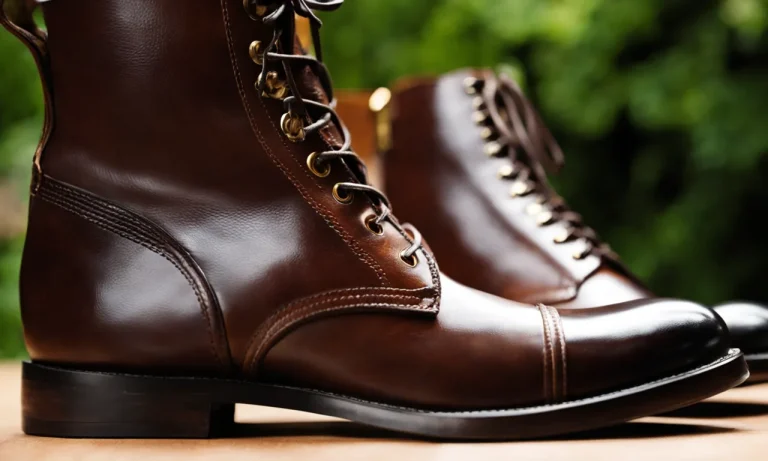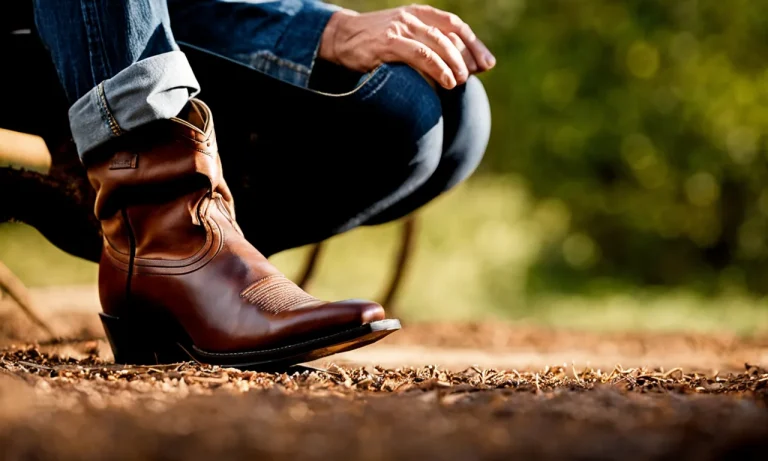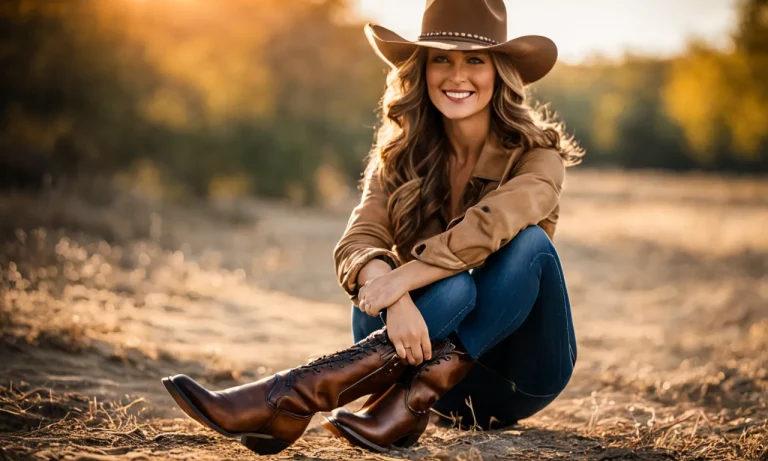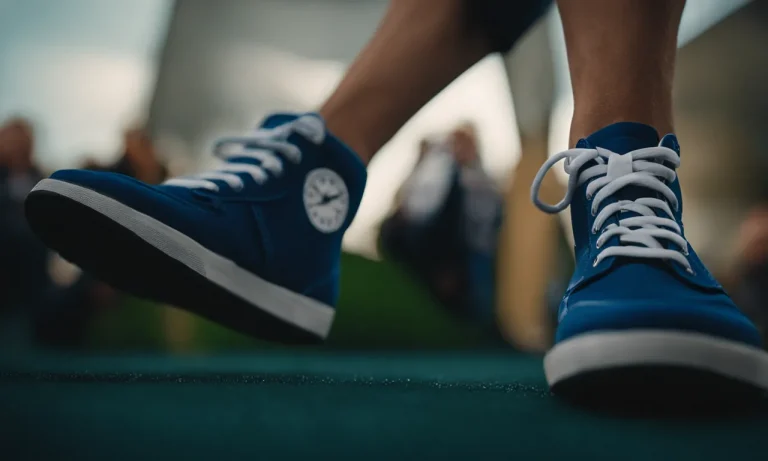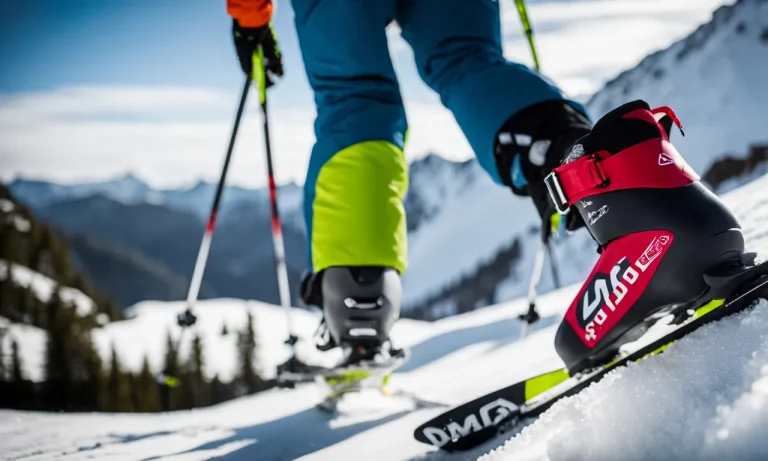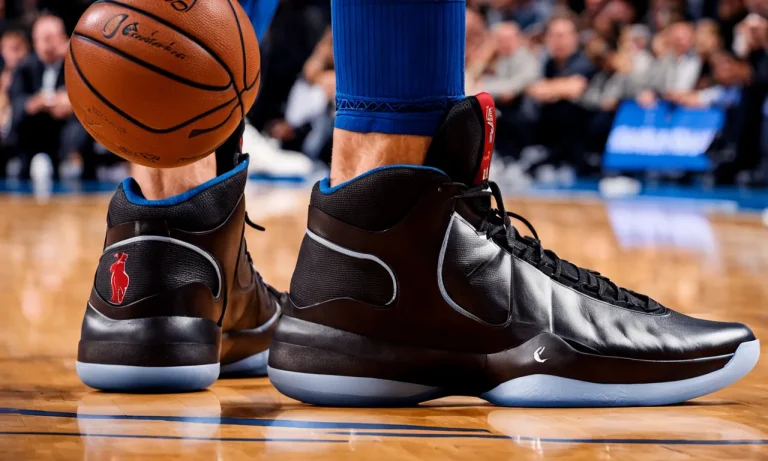Do your toes bang against the front of your shoes when you walk? Or do you have so much extra room that your feet slide around? Getting the right shoe length is an important part of finding comfortable, well-fitting footwear.
If you’re short on time, here’s a quick answer to your question: Your toes should have about a half inch of space between the end of your shoe and your longest toe when you’re standing up straight. This allows your feet room to expand when you walk without jamming your toes.
In this comprehensive guide, we’ll cover everything you need to know to find the ideal shoe length for your feet. We’ll discuss factors like foot shape, occasion, and shoe style that impact fit. You’ll also learn tips for measuring your feet properly and find specific fitting recommendations for running shoes, heels, sandals, and more.
Do Your Toes Normally Touch the End of Your Shoes?
Many people’s toes do touch the ends of their shoes. It is a common occurrence and can happen for a variety of reasons. Each person’s feet are unique, and the length and shape of their toes can differ. As a result, some individuals may find that their toes naturally come into contact with the front of their shoes.
Reasons Your Toes May Hit the Shoe End
There are several reasons why your toes may hit the end of your shoes:
- Shoe Size: If you are wearing the wrong shoe size, it is more likely that your toes will touch the end of the shoe. Ill-fitting shoes can cause discomfort and potentially lead to foot problems.
- Toe Length: If you have longer toes, they may naturally extend closer to the end of the shoe. This can be genetic and is not necessarily a cause for concern.
- Foot Swelling: Throughout the day, your feet may swell slightly, causing your toes to come into contact with the shoe end. This is particularly common in hot weather or after prolonged periods of standing or walking.
- Shoe Design: Certain shoe styles, such as pointed or narrow-toed shoes, may leave less room for your toes to move freely. This can increase the likelihood of your toes touching the end of the shoe.
Potential Problems with Too-Short Shoes
While it is normal for some individuals to have their toes touching the end of their shoes, it is important to ensure that the fit is not too tight. Wearing shoes that are too short can lead to various issues, including:
- Toe Pain: Constant pressure on the toes can cause discomfort, pain, and even ingrown toenails.
- Blisters and Calluses: Friction between the toes and the shoe end can result in blisters and calluses.
- Foot Deformities: Wearing shoes that are too short for an extended period may contribute to the development of foot deformities, such as hammertoes.
If you frequently find that your toes touch the end of your shoes and experience discomfort, it is recommended to consult a podiatrist or a shoe fitting specialist. They can provide professional advice on finding the right shoe size and style that accommodates your foot shape and size, ensuring optimal comfort and foot health.
What Is the Ideal Space Between Your Toes and Shoe End?
When it comes to the space between your toes and the end of your shoe, finding the right fit is crucial for comfort and foot health. While some people prefer a snug fit, others may prefer a little more room for their toes to move. So, what is the ideal space between your toes and shoe end?
Let’s explore some guidelines to help you find the perfect fit.
Guidelines for space in different shoe types
The ideal space between your toes and the end of your shoe may vary depending on the type of shoe you are wearing. For athletic shoes or sneakers, there should be about a thumb’s width of space between your longest toe and the end of the shoe.
This allows for proper toe movement and prevents your toes from hitting the front of the shoe during activities.
On the other hand, dress shoes or heels may have a slightly tighter fit. Aim for about a half-inch of space between your longest toe and the end of the shoe. This provides enough room for comfort while still maintaining a stylish look.
How to measure foot size accurately
Accurate foot measurement is crucial when determining the ideal space between your toes and shoe end. To measure your foot size accurately, follow these steps:
- Stand with your weight evenly distributed on both feet.
- Place your foot on a piece of paper and trace around it.
- Measure the length from the tip of your longest toe to the end of your heel.
- Repeat the process for the other foot, as foot size can vary.
Remember to measure your feet at the end of the day when they are slightly swollen, as this is when they are at their largest size.
Factoring in foot expansion and swelling
It’s important to consider foot expansion and swelling when determining the ideal space between your toes and shoe end. During the day, our feet can expand due to factors such as heat and physical activity.
Therefore, it is advisable to leave a little extra room in your shoes to accommodate for this expansion. This will help prevent discomfort and potential foot problems.
Additionally, certain conditions like pregnancy or foot conditions like bunions or hammertoes can cause swelling. If you have any of these conditions, it may be necessary to consult with a podiatrist to find the best shoe fit for your specific needs.
Trying on shoes to test fit
When shopping for shoes, it’s important to try them on and test the fit before making a purchase. Here are a few tips to help you determine if the shoes fit properly:
- Walk around in the shoes to see if your toes have enough space to move comfortably.
- Check if there is any pressure or discomfort on your toes or the sides of your feet.
- Ensure that the shoes provide enough support and stability for your feet.
- If possible, try the shoes on later in the day when your feet tend to be slightly larger.
Remember, a proper shoe fit is essential for foot health and overall comfort. If you’re unsure about the fit, don’t hesitate to seek advice from a knowledgeable shoe salesperson or a podiatrist.
Shoe Fitting Considerations for Different Foot Shapes
When it comes to finding the perfect fit for your shoes, one size does not fit all. Different foot shapes require different considerations to ensure comfort and prevent foot-related problems. Whether you have narrow feet, wide feet, high arches, or flat feet, here are some fit tips to help you find the right shoe for your foot shape.
Fit tips for narrow feet
If you have narrow feet, it can be a challenge to find shoes that don’t slip or feel too loose. Here are a few tips to help you get the right fit:
- Look for shoes with adjustable closures such as laces, straps, or buckles. This will allow you to tighten the shoes to your desired fit.
- Consider brands that offer narrow sizes or styles specifically designed for narrow feet.
- Try wearing thicker socks or using insoles to fill up the extra space in the shoe.
Fit tips for wide feet
For individuals with wide feet, finding shoes that are comfortable and don’t pinch can be a bit of a challenge. Here are some fit tips to keep in mind:
- Look for shoes with a wider toe box to accommodate the width of your feet.
- Choose shoes made from soft and flexible materials that can stretch to accommodate the width of your feet.
- Avoid shoes with pointy or narrow toe boxes as they can squeeze your toes and cause discomfort.
Fit tips for high arches
If you have high arches, you may experience issues with arch support and stability. Here are some fit tips to consider:
- Look for shoes with good arch support to help distribute weight evenly across your feet.
- Consider using orthotic inserts to provide additional support and cushioning to your arches.
- Avoid shoes with flat soles, as they may not provide enough support for your high arches.
Fit tips for flat feet
Individuals with flat feet often require shoes with extra arch support and stability. Here are some fit tips to keep in mind:
- Look for shoes with built-in arch support or consider using orthotic inserts to provide the necessary support.
- Choose shoes with a firm midsole to provide stability and prevent overpronation.
- Avoid shoes with high heels or excessive cushioning, as they can exacerbate foot pain for those with flat feet.
Remember, finding the right shoe fit is essential for your foot health and overall comfort. If you’re unsure about your foot shape or have specific foot-related concerns, it’s always a good idea to consult with a podiatrist or shoe fitting specialist for personalized advice.
How Shoe Length Varies By Occasion and Use
Fitting Dress Shoes
When it comes to fitting dress shoes, it is generally recommended to have a little bit of space between your toe and the end of the shoe. This allows for natural movement and prevents discomfort. Ideally, there should be about a thumb’s width of space between your longest toe and the end of the shoe.
However, it’s important to note that different shoe styles and brands may have slight variations in fit, so it’s always a good idea to try on different sizes and styles to find the best fit for your foot.
Additionally, it’s important to consider that leather shoes tend to stretch and mold to your foot over time, so they may feel slightly snug at first but will eventually become more comfortable.
Fitting Running Shoes
When it comes to fitting running shoes, it’s important to have a snug fit to prevent any slippage or discomfort while running. Your toe should not touch the end of the shoe, but there should be enough space for your toes to wiggle comfortably.
Running shoes should have a little bit of extra room in the toe box to accommodate the natural swelling of your feet during exercise. It’s also important to consider the type of running you’ll be doing.
For long-distance running, you may want to have a slightly roomier fit to allow for more movement, while for sprinting or track running, a snugger fit may be preferred for better control and responsiveness.
Fitting Heels
When fitting heels, it’s important to find the right balance between comfort and stability. Your toe should not be pressed against the end of the shoe, as this can cause discomfort and even lead to foot problems over time.
The fit of heels can vary depending on the style and height, so it’s important to try on different sizes and styles to find the best fit for your foot. It’s also a good idea to consider the width of the shoe.
If your feet tend to be wider, you may need to go up half a size to accommodate for a more comfortable fit.
Fitting Sandals
When fitting sandals, it’s generally recommended to have a little bit of space between your toe and the end of the shoe. This allows for natural movement and prevents discomfort. Sandals should have a bit of wiggle room for your toes to move freely.
However, it’s important to note that different sandal styles may have different fit requirements. Some sandals, like flip-flops, may have a more relaxed fit while others, like strappy sandals, may have a more secure fit.
It’s always a good idea to try on different sizes and styles to find the best fit for your foot.
How to Size Shoes Correctly for Kids
When it comes to choosing the right shoe size for your child, it’s important to consider their comfort and foot development. One common concern parents have is whether their child’s toe should touch the end of the shoe. Let’s explore some tips on how to size shoes correctly for kids.
Allowing room for growth
Children’s feet grow rapidly, so it’s crucial to allow for some room in their shoes to accommodate this growth. The general rule of thumb is to leave about a thumb’s width or half an inch of space between your child’s longest toe (not necessarily the big toe) and the end of the shoe.
This extra space ensures that their feet have room to grow without feeling cramped or restricted.
It’s important to note that shoes that are too big can also cause discomfort and affect your child’s gait. Therefore, finding the right balance between allowing for growth and ensuring a proper fit is key.
Getting properly fitted
Getting your child’s feet properly measured is essential in finding the right shoe size. Many shoe stores have trained staff who can assist you in this process. They will measure both the length and width of your child’s feet to determine the most suitable shoe size.
It’s also important to consider the shape of your child’s feet. Some children may have wider or narrower feet, so finding shoes that accommodate their specific needs is crucial for their comfort and overall foot health.
Monitoring fit as feet grow
As your child’s feet continue to grow, it’s important to regularly check their shoe size. Children’s feet can grow rapidly, especially during growth spurts. A shoe that fit perfectly a few months ago may now feel tight or uncomfortable.
Keep an eye out for any signs of discomfort, such as redness, blisters, or your child complaining of pain. These could be indicators that their shoes no longer fit properly and it’s time to consider getting a new pair.
Remember, finding the right shoe size for your child is essential for their comfort, foot development, and overall well-being. By allowing room for growth, getting properly fitted, and monitoring fit as feet grow, you can ensure that your child’s shoes provide the necessary support and allow their feet to develop naturally.
When to Size Up or Down
Choosing the right shoe size is crucial for the overall comfort and health of your feet. While it’s important to have a proper fit, many people wonder if their toes should touch the end of their shoes. The answer, however, is not a simple yes or no.
It depends on various factors, such as foot issues, foot shape, and the need for orthotics or inserts.
Sizing up for certain foot issues
If you have specific foot issues like bunions, hammertoes, or ingrown toenails, sizing up may be necessary. These conditions can cause discomfort or pain when the toes are cramped against the shoe. By choosing a slightly larger size, you can provide more room for your toes and alleviate any pressure or rubbing.
Remember, the shoe should still fit snugly around the heel and midfoot to provide proper support.
In some cases, orthopedic or podiatrist-prescribed orthotics may also require a larger shoe size. These custom-made inserts are designed to correct foot alignment and provide additional support. If you need to accommodate orthotics, consult with your healthcare provider or a knowledgeable shoe fitter to ensure you choose the right size.
Sizing down for narrowed feet
On the other hand, if you have narrow feet, sizing down might be necessary to achieve a proper fit. Shoes that are too wide can cause your feet to slide around, leading to blisters and discomfort. By choosing a smaller size or opting for narrow-width shoes, you can ensure a more secure fit and prevent any unnecessary movement.
It’s important to note that sizing down should not result in your toes being cramped or squished. The shoe should still provide enough space for your toes to wiggle comfortably. If your toes feel cramped, it’s better to look for a different shoe style or brand that offers a better fit for your foot shape.
Accommodating orthotics or inserts
If you wear orthotics or inserts, it’s crucial to choose a shoe that can accommodate them properly. Some shoes have removable insoles that allow you to replace them with your own custom inserts. In this case, you might need to size up slightly to ensure enough room for both the inserts and your feet.
However, if the shoe does not have removable insoles, you might need to size up more significantly to accommodate the extra volume. It’s recommended to consult with a shoe specialist or your healthcare provider to find the best solution for your specific needs.
Conclusion
Finding shoes that properly accommodate your feet without jamming your toes takes some trial and error. Focus on getting an accurate measurement of your feet and pay attention to fit as you walk around in shoes to make sure there is adequate space.
Around a half inch between your longest toe and shoe end is ideal for most people. But adjust this based on your individual foot shape and any swelling. Proper toe room keeps your feet comfortable and avoids injuries over time.
With the tips in this guide, you can find shoes in all styles that allow your feet to move naturally without banging into the ends. Your toes will thank you!

